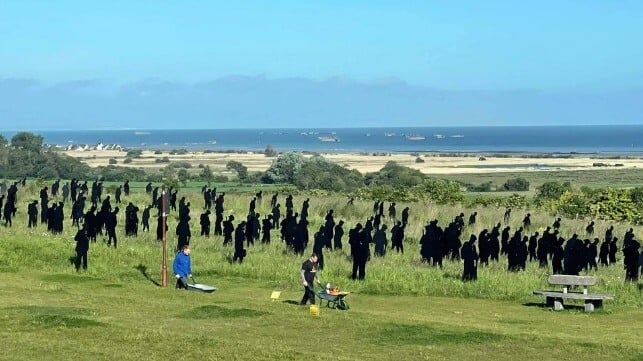As 80th Anniversary of D-Day Approaches, Royal Navy Honors the Fallen

The crew of Britain’s newest frigate followed in the footsteps of their D-Day forebearers by visiting the sites where HMS Glasgow fought 80 years ago.
In 1944, the Town-class cruiser – sister ship of HMS Belfast, which also pounded German positions on June 6 – largely aided the efforts by US forces to storm Hitler’s vaunted Fortress Europe. On D-Day itself, Glasgow’s six-inch guns concentrated their firepower at Omaha Beach and subsequently shifted position as the campaign progressed to help American troops capture the Cotentin Peninsula and the key port of Cherbourg.
Just to the west of the city lies Querqueville, heavily fortified in 1944 and subjected to a bombardment from HMS Glasgow – the cruiser’s last action of the Normandy campaign. It was there that the battlefield tour by crew of today’s Glasgow – the Royal Navy’s first Type 26 anti-submarine frigate, undergoing fitting out on the Clyde – and some of the shipwrights involved with building her concluded.
The team headed to France ahead of next month’s international commemorations which will see world leaders converge on the shores of Normandy. They followed not merely follow in the ‘footsteps’ of the old cruiser, but also Glaswegians who fought in Normandy, beginning at Sword Beach where Bill Millin famously piped commandos ashore amid the maelstrom of war.
Just a mile inland from the beach, the party paid tribute to the fallen who are laid to rest at Hermanville-sur-Mer Commonwealth War Graves Cemetery. Marine engineer Lieutenant Lee Clemens led a short service of remembrance on behalf of the 900 souls buried there and placed a wreath on the grave of 21-year-old Lance Corporal Vincent Costello from Nitshill, Glasgow, who died five days into the landings while fighting with 5th Battalion Black Watch.
The tour continued on to Pegasus Bridge, famously seized by airborne forces in the first minutes of D-Day; Caen – an objective for British forces on D-Day, but not captured until July; and the German gun emplacement, the Longues-sur-Mer battery.
“It was a fantastic opportunity for both Ship’s Company and members of BAE Systems Maritime to learn about the history that the Royal Navy played during the D-Day events,” said HMS Glasgow Commander Phil Burgess, Senior Naval Officer.
His ship is due to enter service later this decade, the first of eight vessels to replace submarine-hunting Type 23 frigates currently with the Fleet.
The opinions expressed herein are the author's and not necessarily those of The Maritime Executive.
